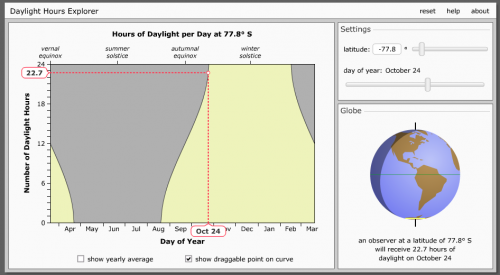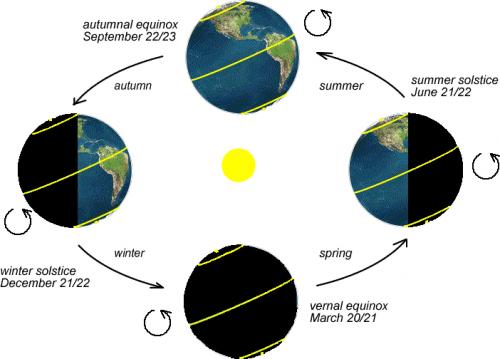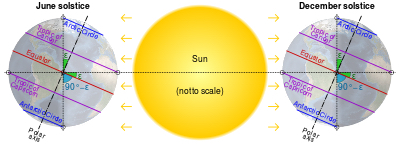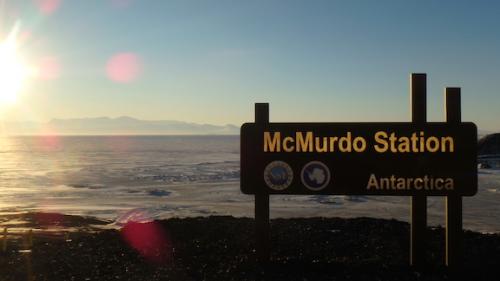Early Monday morning we saw the last sunset of 2016, at 1:26 am, followed shortly by the last sunrise of 2016, at 1:46 am. While in principle I am in favor of endless sunshine, it's also a little baffling to think that the next sunset won't happen until February 16, 2017, almost four months from now. How is this possible? It's actually an aspect of life in the Earth's polar regions and it's all due to the relationship between the planet's orbit around the sun, its angle of tilt, and the latitude where the people observing all of this are standing.
 McMurdo Station is entering a period of 24 hours of daylight. (http://astro.unl.edu/classaction/animations/coordsmotion/daylighthoursexplorer.html)
McMurdo Station is entering a period of 24 hours of daylight. (http://astro.unl.edu/classaction/animations/coordsmotion/daylighthoursexplorer.html)
In order to understand how this all works out, we need to think about circles. The Earth itself orbits the sun in an elliptical orbit which takes slightly more than 365 days to complete. At the end of each orbit, it returns to the same position in space relative to the sun. The imaginary circle around the center of the Earth which falls in line with its rotation is the equator. Its halfway in between the southern end - the South Pole - and the northern end - the North Pole. Standing at the equator, you would expect to see 12 hours of daylight and 12 hours of darkness as the planet rotates through 360 degrees in 24 hours. That is, you would expect to see this IF Earth's axis of rotation (the imaginary line drawn through the Earth between the poles, around which the planet rotates) was perpendicular to its path through space (its orbit). Earth's axis of rotation is actually 23.5 degrees offset from its orbital path; in other words, its got quite a bit of tilt to it. This sounds scary and unstable, but its actually what gives us the seasons. As Earth moves through its annual orbit, the side tilted slightly toward the sun experiences the long days and short nights of summer, and the side facing away experiences winter. Because of this tilt, the farther away an observer moves from the equator, the longer the day length they experience in summer and the shorter in winter.
 A northern hemisphere perspective on how Earth's orbit around the sun and its angle of tilt explain the seasons. (http://astronomy.nmsu.edu/geas/lectures/lecture06/slide05B.html)
A northern hemisphere perspective on how Earth's orbit around the sun and its angle of tilt explain the seasons. (http://astronomy.nmsu.edu/geas/lectures/lecture06/slide05B.html)
The distance from the equator is measured in degrees of "latitude," and is described in terms of a circle of 360 degrees, with zero degrees being the equator. Move between the equator and the North Pole and you've traveled 90 degrees of latitude (360 degrees of the circle divided by four) and there is no more "north" to go. The same is true for traveling to the South Pole. If you travel between the North and South Poles, you've traveled 2 x 90 = 180 degrees; halfway around the imaginary circle that runs across both poles. Because Earth is tilted about 23.5 degrees, the pole facing the sun at a particular time of year sees much more sunlight. In fact, if you draw an imaginary circle of latitude at about 66.5 degrees (north or south), an observer standing anywhere on that circle could expect to see the sun above the horizon for at least 24 hours once each year. It just so happens that 90 degrees (the distance between the pole and equator) minus 23.5 degrees (Earth's angle of tilt) equals 66.5 degrees.
 The tilt of the planet, the pole closest to the sun, and the angle that sunlight hits a given spot on the Earth's surface explains day length. (https://upload.wikimedia.org/wikipedia/commons/4/40/Axial_tilt_vs_tropical_and_polar_circles.svg)
The tilt of the planet, the pole closest to the sun, and the angle that sunlight hits a given spot on the Earth's surface explains day length. (https://upload.wikimedia.org/wikipedia/commons/4/40/Axial_tilt_vs_tropical_and_polar_circles.svg)
Almost all of the continent of Antarctica falls inside the imaginary circle drawn on a globe at about 66.5 degrees south latitude known as the "Antarctic Circle." The farther inside the Antarctic circle, the higher your latitude and the greater your amount of sunlight in summer. McMurdo Station lies at 77.8 degrees South, so as early as late October, the station experiences 24 hours of daylight as the sun traces the horizon all day long. In the southern hemisphere, summer is rapidly approaching and the long daylight hours will bring relative warmth as well as big changes for the organisms and people that live here.
 As close as McMurdo Station will get to night time for awhile.
As close as McMurdo Station will get to night time for awhile.
